Rabbits... from the moment you saw one, you fell head over heels for them. They’re cute. They’re fluffy. They’re warm. You just want to cuddle with them all day long. So, you decide to keep one around that you can play with as you wish.
In trying to decide how you are going to house your bunny, you may have come across a lot of options in the area of rabbit cages. This list will give you a variety of options. We understand every person has different needs and requirements for their bunny. This list takes a complete look at those combinations of requirements. The following are a variety of cages we picked out for you.
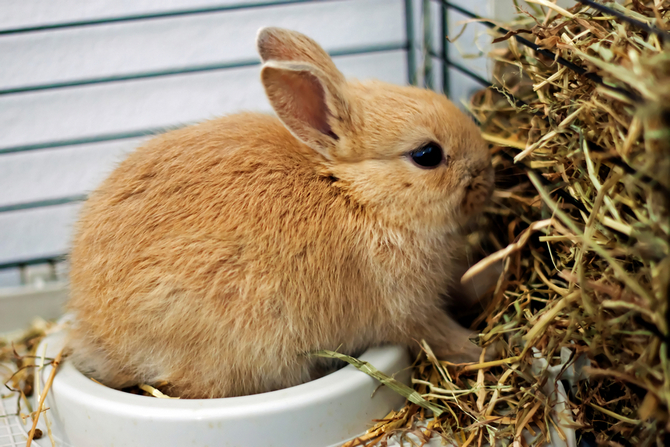
Top 10 Rabbit Cages
1. Living World Deluxe Habitat
Best Large Rabbit Cage
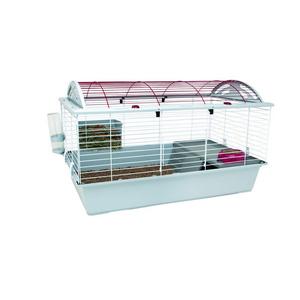
Here is a cage that does not compromise on build quality and durability. It is built using a mesh frame for the top and sides, with a plastic bottom. This setup allows for excellent ventilation and visibility. The wire top swivels open in case you'd like to get to your fluffy pet in a hurry. The few seconds you can save getting to cuddle your rabbit are precious. It comes with a tip-proof dish that can be held in place firmly.
The cage also has a balcony with a ramp that your rabbits will enjoy. Underneath the balcony is an enclosed space that your rabbit can use to hide. It also comes with a hay feeder which you can load from the outside.
It comes in two parts; the top wire mesh half, which easily clips on to the bottom half. The bottom pan is 7.5 inches deep. This is vital to stopping your rabbit splashing its environs when it is handling its waste business. It is noted as being one of the best large size cages for rabbits.
Why we like it: It comes in three sizes; standard, large and extra-large. The large sizes on offer make it a great habitat for your rabbit to run around in and stretch as much as they wish to. The lightweight makes it easy to access and move around.
- Easy to clean.
- Large enough to house two medium rabbits
- Easy to put together as it uses plastic clips for assembly.
- Great for litter-trained rabbits.
- Instructions are not so clear.
- The platform is a little steep for smaller bunnies to use
2. AmazonBasics Pet Habitat
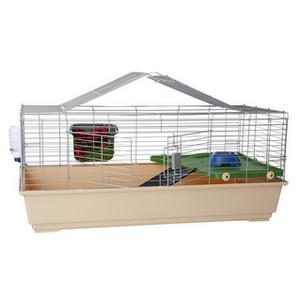
This rabbit cage is built to adhere to standards set forth by California’s Proposition 65, which seeks to protect drinking water from substances and contaminants that are known to cause cancer and other diseases. It uses PP plastic which does not expose your rabbit to harmful substances.
This cage has doors to the top and the sides. This makes for easy and convenient access for when you want to clean, feed or let your rabbit out to play. The “A” frame of the top doors also makes for a stylish top door.
It also comes with a balcony for when your fluffy bunny is looking for a change of scenery. The platform also doubles up as a hiding space. When your rabbit is feeling exposed, they can simply go underneath the platform.
This comes in two parts for easy assembly. The top half, the wire mesh, simply clips on to the bottom half which is a PP plastic pan.
Why we like it: It is available in three different sizes; standard, large and jumbo. The adherence to California’s Proposition 65 ensures your rabbit will not develop debilitating diseases like cancer. The jumbo cage has measurements of 47.2 x 23.6 x 20.5 inches (LxWxH). It weighs 19 pounds. It also comes with a limited one-year warranty from Amazon.
- Easy to clean.
- Easy to put together.
- The ramp to the balcony is friendly to smaller bunnies.
- Comes with a hay guard to prevent food spillage.
- The plastic platform cracks easily when it is put under repeated stress.
- The food bowl is too small for more than one rabbit.
3. Midwest Wabbitat Folding
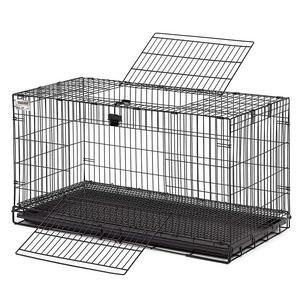
The designers of this cage put some thought into their work when they were coming up with this one. The cage has two big access points; one on the top and another to the front. This allows easy access to clean and play with your rabbit. The front access door can also act as a ramp for your rabbit to get in and get out as they please.
The latches are engineered to enable one-handed operation. This is especially useful if you have a bunny that does not know when playtime is over, or simply chooses to ignore it. Setting up this cage is a 5-second affair. It does not require any tools, simply latching the sides together will do. The all metal construction ensures that this is a sturdy and durable cage.
An excellent feature of this is the floor. It is a slide-out floor pan. This makes cleaning an easy and convenient operation. It also has a mesh grate. You can have your rabbit rest on the pan instead if you prefer that.
Why we like it: This was a well-researched and well-thought design. They even added in a urine guard that protects the cage and surrounding areas from splashing whenever your rabbit handles its business.
- Probably the easiest to clean cage on the market.
- It is collapsible. You can fold and put it away when not in use.
- The largest size it comes in measures at 37 x 19 x 20 inches (LxWxH). This is smaller than some of the products of other makers who offer much larger sizes.
4. Kennel-Aire "A” Frame Bunny House
Best Cheap Indoor Rabbit Cage
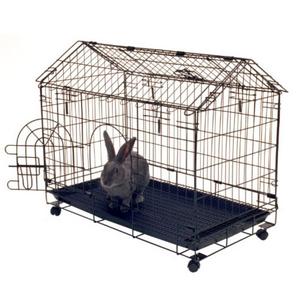
This cage stands out on design alone. It is made to look like a cozy and functional pet house on the prairie. It also comes with four heavy-duty wheels. Unless you are going upstairs, you don't need to carry this cage around.
It is an all metal construction, thus making it a sturdy and durable cage. The “A” frame roof gives the rabbit enough room to sit up and stretch. It is also constructed with two doors, thus making it easy to access your rabbit whenever you need it.
At 16.5 pounds, it is one of the lightest cages on the market. This makes for great portability when you’re traveling. It is also built to be easily collapsible. This means you can set it up and collapse it down quickly without needing a manual. It is also noted for being one of the best indoor rabbit cages on offer and also a great value for the price.
Why we like it: It comes with an easy pull out tray at the bottom. This makes it a breeze to clean. The wheels also make it easy and convenient to move around the house. This can come in handy whenever there is a chill in the air and you want to move it to a warmer location.
- It is easy to clean.
- Easy to move around.
- The all metal construction makes it sturdy and durable.
- The great height makes it convenient for your rabbit to sit up in it and stretch.
- It is not the largest cage out there. This one measures 29.5x16.5x24 inches (LxWxH).
- The mesh floor could become a problem in the long term. This is especially true if you keep your rabbit caged for long periods of time.
5. Ware Manufacturing Home Sweet Home Pet Cage

The thing that stands out about this cage is the minimalist design. Simple enough, unassuming yet functional. A wire mesh makes up the top half of the setup. The bottom is simple plastic that is of a heavy-duty build. The wire mesh is coated with chew proof powder to prevent your rabbit from snacking on the cage and hurting its teeth in the process.
The top half is firmly held on to the bottom half by using six clips. This also makes it easy to set up without the use of a product manual. It comes in three different sizes, so this is convenient for whatever size and number of rabbits you have.
It is available in different colors. You can, therefore, choose a different color that fits in with the palate of your home;or you can make it stand out. At 12.5 pounds, this is one of the most lightweight products on the market. Combine this with how easy it is to set up, and you have a very portable enclosure for your rabbit.
Why we like it: This is a two-piece design that makes it very easy to assemble. Just put the wire mesh top on the plastic bottom and clip on. This makes it easy to take apart and clean.
- The clip-on design makes it easy to assemble and take apart. This makes it suitable for travel
- This cage gives your rabbit enough room to stretch and hop. The largest measures in at 40x20x20 inches. (LxWxH)
- Has only one door. Accessing your bunny is only through the front.
6. MidWest Homes for Pets Wabbitat Deluxe Rabbit Home Kit
Best Extra Large Indoor Rabbit Cage
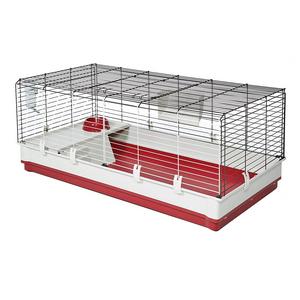
If you’re looking for something extra-large, then this is the right product for you. Measuring in at 47.16x23.62x19.68 inches (LxWxH), this cage will give your rabbit maximum room to stretch, hop about and even stand. It also comes with a 5.5-inch-deep plastic pan that prevents urine from splashing over to the environs. The balcony provides the rabbit with a change of scenery. It is easy to put together as the top half simply clips on to the bottom half.
The space underneath the balcony also provides the rabbit with a convenient location to hide whenever they’re feeling anxious or want to be alone. Access is convenient with this cage. The side door measures the same as the entire width of the cage. This makes it a convenient way to access and clean the cage. It also has a top door for whenever you are looking for quick access to your rabbit.
This cage is noted for being one of the best extra-large size indoor cages on offer. With such a size, you can give your rabbit a partner and not worry they will lack space to play and stretch.
Why we like it: The real estate, the size of this cage makes it a superb rabbit home. The extra room to play makes it a convenient choice just in case you have to leave your rabbit caged for a long period. It also comes with a hay feeder and a water bottle.
- Expanding the size of the cage with accessories is possible.
- It is easy to clean.
- The construction materials make it a comfortable and strong enclosure.
- The side door requires a lot of room to open. This is because the door opens outwards going up.
7. Ferplast Krolik 140 Plus

This cage was built with the privacy of your pet in mind. It comes with a wooden house where your rabbits can nest or when they need privacy. The house can be placed on either end of the cage for convenience. In case you have more than one rabbit, the house can also be used to separate the rabbits.
The cage has a large opening that runs across its entire length. A deep pan of 6 inches ensures that your rabbit will not splash urine around, or even kick out the bedding when they throw a fit. The inclusion of a platform will give your rabbit a change of scenery whenever it needs it. When coupled with the house, the space underneath the platform can be a hiding place for your multiple rabbits.
Despite its size, it is surprisingly easy to move around. It can be completely knocked down for easy storage or when you need to move. Assembling without the use of a product manual is easy. It uses clips to hold it together.
Why we like it: This is a large cage. It is suitable for housing several rabbits together. It measures in at 55.9 x 23.6 x 19.7 inches (LxWxH). It also comes with a feeding platform that smaller rabbits can hide under, a sturdy water bottle and a hay feeder.
- It is easy to clean.
- The large size makes it possible to have multiple bunnies in the same cage.
- The large door makes accessing the cage very easy.
- The rabbit house it comes with also opens at the top.
- If you have an active bunny, opening the side door will definitely give them enough room to sprint out of the cage.
8. PawHut Metal
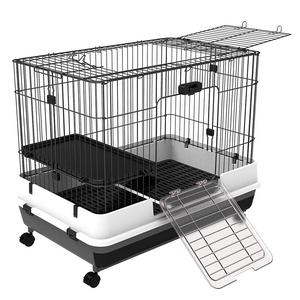
PawHut put their design caps on for this one. They were able to combine beauty, style, and functionality to come up with this enclosure. The construction is all metal thus making it sturdy and long lasting.
The side door doubles as a ramp that the rabbit can use to get in and out as they please. The top opening adds to the overall ease of access this cage offers. The wire cage is coated in powder that is chew proof.
The height of the cage gives your fluffy bunny plenty of room to stretch and sit up. The overall dimensions are guaranteed to give your rabbit enough room to play. The addition of a platform is a bonus.
An excellent feature of this is the wheels. They make it easy to move and transport. It also comes with a comfortable floor mesh that is specifically designed not to hurt their feet, in which sore hocks will develop on the feet of your rabbit. This means that it also comes with a slide out tray. This makes it easy to pull out and clean.
Why we like it: If you like to have stylish things around your house, this will blend in and add style and purpose. Apart from being functional, the design is also easy on the eye. The choice of materials used to make this enclosure are a guarantee that they will last for a long time.
- The platform and ramp make it fun and easy to access the cage for your rabbit.
- The slide-out tray design makes for an easy-to-clean setup.
- The floor grids are engineered to be comfortable for your rabbit if they spend long periods of time in their cage.
- The latches could have been built better. The package needs to be handled with care during transit.
9. Prevue Pet Small Animal Home on Stand
Best Rabbit Cage on Wheels

This has to be the best-wheeled cage on the market. Measuring in at 33.5’ long x 20.5’ wide x 33’ high, the enclosure is spacious enough for your rabbit to hop around and stretch as much as they wish to.
The caster wheels add to the overall functionality of this enclosure. Aside from being able to move around with it indoors, the overall height of the stands makes it easy to be able to move around outdoors. The tubular metal design of the stand makes this a robust and durable design.
The ramp and the tray are friendly to smaller bunnies. For ease of access, there are two doors: one to the side and another on the top. It also comes with a deep tray, enough to contain any messes made by two rabbits over a period of time.
Why we like it: Measuring in at 32x21.5x33.5 inches (LxWxH), this cage is roomy enough to have two rabbits in the cage. The deep dish also ensures that when your rabbit does his business, it stays in the pan. If you decide not to use the wire mesh flooring, the deep pan will also come in handy. It will ensure that when your fluffy bunny decides to kick out his bedding, it won’t fly out of the cage. This cage is noted for being one of the best cages on wheels.
- The metal design makes it sturdy.
- It is easy to assemble. The only tool required during assembly is supplied with the package.
- The wire grid floor makes this cage simple and easy to clean and maintain.
- Active rabbits can easily detach the ramp and platform and throw them around.
10. Kaytee My First Home 2-level Pet Habitat
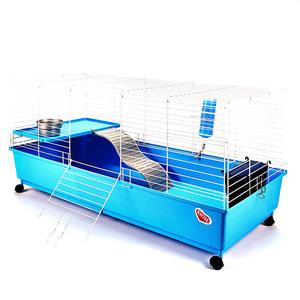
If you would like to venture out into rearing rabbits, or this is your first time having one as a pet, then this would be a lovely place to start. It is easy to assemble as it comes with two parts. The top wire mesh cage easily clips onto the bottom plastic pan.
The plastic pan is 8.8 inches deep, which helps to ensure waste is not spread to the environment when your rabbit does his business. It also allows the rabbit a bit of privacy, especially if they are feeling anxious.
It also comes with a balcony and a platform that is friendly to a small bunny. Included in the package are a food bowl, water bottle, and a hay feeder. The best part of this is that it is wheeled. This makes it easy to move around in case you want to change the position or protect the rabbits from a draught.
Why we like it: The large side door also doubles up to be a ramp. This makes it easy for the rabbit to get in and leave as they please. The simple construction means it is easy to maintain. If your child is the one who is raising their first rabbit, the simplicity of this cage is a good learning opportunity.
- The cage is large enough for small bunnies to stretch and hop about.
- It is easy to clean.
- It is easy to put together even without instructions.
- Does not have a top door to ease access for cleaning.
Guide: Rabbit Cage vs. Hutch
What is a hutch?
Rabbits love to run around and jump a lot. This is a major thing to consider when deciding which of the two types of housing to pick.
A hutch is a traditional setup for housing rabbits. These are kept outside, and they typically can be made to be as large as you see fit. They are traditionally made of wood, and they are divided into two compartments.
The first part compartment is made of wire mesh to allow your fluffy bunny to experience the sun and wind. The second compartment is walled off from the elements to protect the precious little thing. When the conditions worsen outside, your rabbit will have a refuge that they can use to keep from getting hurt by the elements.
They usually have roofs that open up to allow easy access for general cleaning. And petting the rabbits. Okay, and taking the rabbits out to play.
Critical factors to consider when buying a hutch
Rabbits are known to chew a lot of things. If you do decide you are getting a hutch, shop around for one where the wood wasn’t treated with chemicals. In case the rabbit chews the wood, this may harm your rabbit in the long term. If you can find one coated in chew-proof dust that would be even better as this will protect the rabbit from ingesting what is not meant to be food.
Why you should get a rabbit hutch
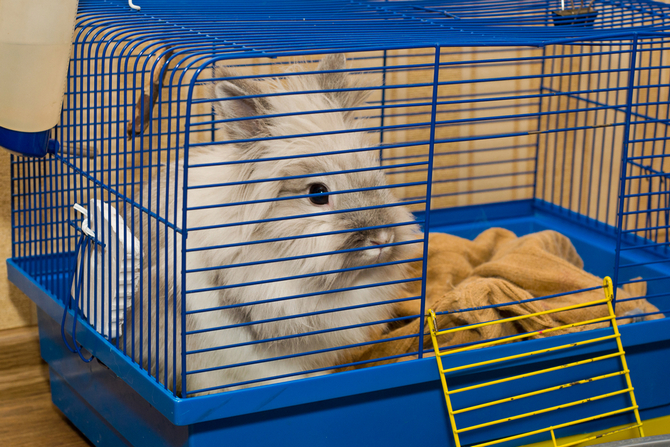
If you do not move around a lot, a hutch may make more sense to you. This will also not take up precious space inside your home. It also keeps your home odor free. The smell of ammonia is especially strong immediately after a rabbit does its business. This can really put off people with a keen sense of smell. If your rabbit is also not neutered, there is a high chance it may splash its environs when doing its business. Having a hutch will help keep your home rabbit waste free. Well, unless you let them into the house and you are yet to litter train them.
If you live in an area that experiences winter, you can choose to make your hutch winter-proof. Although ventilation is important for your heat-sensitive bunny, leaving them to face a draught is not advisable. You can use a clear plastic sheet to prevent draughts from getting to your rabbit. This will allow your rabbit to see the light of the sun still and adjust its routine accordingly.
In case the weather gets extreme, you can weatherproof the hutch. Using a well held down tarpaulin, you can cover the hutch to prevent the elements from getting to your fluffy friend.
In case the weather dips below freezing point, there are a variety of microwave heating pads available for you to use. It is not advisable to use a hot water bottle as your fluffy friend may get curious and decide to nibble on it.
What type of flooring should you choose for the hutch?
One thing to consider is the flooring. You can have one made of hard wire mesh. This allows for easier cleaning. They usually have pans underneath them that allow you to remove the droppings and change the litter. A drawback of this is that wire mesh can be really uncomfortable for the rabbit. This might even hurt heavier breeds like the Flemish Giant. If you do choose the wire mesh option, ensure that the second compartment has a solid floor to give the fluffy one some rest from the punishing wire mesh.
If you decide to use a wire mesh floor, there are a variety of beddings that you can use to line the floor to minimize chances of your rabbit developing injuries or even sore hocks.
You can also choose to have solid floors for the hutches. A solid floor will be much more comfortable for the fluffy one. The main drawback, however, comes when you would like to clean them. Solid floors require much more care. The rabbits have to be moved elsewhere to allow the beddings to be removed and the litter changed.
A good way to keep solid floor hutches clean is to litter-train the rabbit. This can be done by placing a tray in the enclosure. The tray can then be cleaned and sanitized with ease.
What is a rabbit cage?
While having the rabbits around in your garden may look like fun, exposing them to the elements may be problematic for their health. A good compromise would have them indoors, with access to the outside world to go expend some energy.
If you decide to keep the fluffy one inside the house, then you will need to find yourself a good cage. Since this will be the fluffy one’s main abode, it is of paramount importance that it be comfortable. This means you will have to find a cage that is at least four times the size of the rabbit. A good option is to have a cage that has shelves. Another option is to have one that has more than one story. This gives the rabbit an option to get off the flooring whenever they want to or feel like it.
A cage has one handy convenience over a hutch. Cages are almost always portable. This makes it easier to move around in case the need arises. They are small enough to fit in cars or RVs. You can bring your rabbit with you when you decide to go on that long journey.
Cage or Hutch, which of the two should you choose?
If you have a large garden, giving your rabbit room to run and would be the better option. A hutch would be better in this situation. You can have a large one built and have your rabbits roam wherever and whenever they feel like.
If you live in an apartment, or your garden or backyard has other uses, a cage would be ideal. This will allow you access to your cuddly bunny at any time. It’s also a good way to shield them from the elements.
A general warning though, don’t keep them on the balcony during the summer months. Your bunny cools its body temperature through the veins in the ears. A balcony may not be the best place to put them as they may not be properly ventilated.
What type of bedding should you use in your rabbit’s cage or hutch?
The type of bedding you use matters when it comes to how comfortable your rabbit will be. Some rabbit beddings can become health hazards to your bunny.
- Clay kitty litter may be a good choice for your rabbit to sit on. However, if the hutch or cage is not placed in a well-ventilated area, the dust may irritate your rabbit.
- Sisal mats are good bedding to use if you decide to use wire mesh flooring. This will protect the feet of your rabbit from injury. It is also light and easy to clean.
- Newspapers are a good, cheap, and easy to source alternative. They are easy to use if you want to clean your cages faster. If the rabbit doesn’t get enough play time, they might rip up the newspapers. The ink from the newspapers can be harmful to the rabbit if they eat too much.
- Shredded cardboard may be a better product when compared to newspapers. They can provide insulation in the hutches. They are also absorbent.
- Straw is good bedding for your bunny. It can provide insulation and warmth for your rabbit. Ensure you have enough stocked up as it is not very absorbent.
- Hay. Yes, hay. It is a good meal for your rabbit. It also makes for very good bedding for keeping your fluffy one warm and comfortable. When buying hay, make sure it has a sweet smell and does not have mold in it.
- Sawdust is the most common type of bedding used. If you do decide to use this, ensure that the hutch or cage is well ventilated. Studies have linked sawdust to liver disease in rabbits.
- Wood pellets have recently gained in popularity. They are mostly used as cat litter. They are quite absorbent. A downside of this is they break down when wet due to expansion. This results in dust forming when they dry up and break down.
- Paper pellets are made to operate in a similar manner to wood pellets. They are made from recycled paper thus making them eco-friendly. They are quite absorbent. A distinct advantage they have is that they do not expand as much as wood product beddings. They also weigh a fraction of the weight of wood-based beddings.
- Paper Pulp is an emerging product. It is made from recycled paper. This makes it environmentally friendly. A good advantage it has is it can absorb moisture as much as three times its own weight. This makes it pocket-friendly as you don't have to use a lot. It is also good at controlling odors.
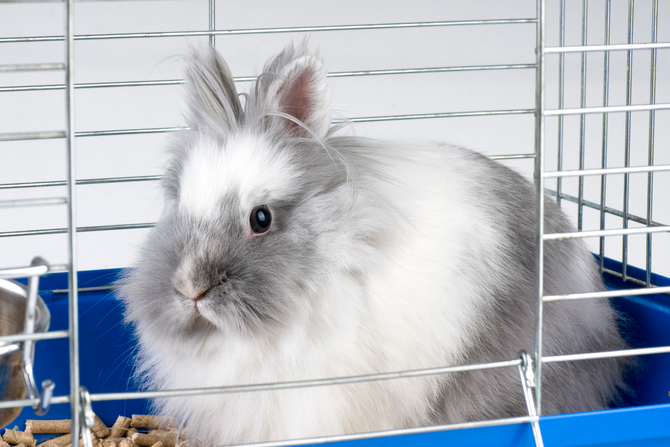
FAQ
What does a rabbit need in its cage?
- Mosquito netting is essential to protect the rabbit from flying insects. Mosquitoes are known to infect rabbits with a disease called myxomatosis. This is a viral disease caused by the Myxoma virus. It has adverse effects in rabbits, and if left untreated, it is fatal.
They also cause Calicivirus, also known as Rabbit Hemorrhagic Disease. The disease destroys internal organs, and the result is hemorrhaging or bleeding. This is also fatal if left untreated.
- Companionship is important for rabbits. They are social animals and therefore require frequent socialization. You can provide this by frequently letting out your rabbit to play with you, or having another rabbit with it. To avoid unwanted litters, you can have same sex rabbits, or separate the males from the females.
- A litter box is important if you want to keep your rabbit indoors. Rabbits can be litter trained, even though they might not use it immediately. Be patient as you teach them. A triangular litter box that can be placed in the corners would be a perfect fit.
- A food bowl is a must-have in your cage. Choose one that the rabbit would find difficult to tip over. This can be one with a heavy base or long enough to have a stable base. You can also find some that can be bolted to the bottom of the cage or clipped to the corners.
- Water is the most important thing your rabbit will need. There are two ways you can give water to your rabbit. One way to do this is to use a water bottle. Most water bottles for rabbits come with a hook that you can use to attach to the sides of the mesh. Another way you can attach the bottle is to use a bicycle bottle holder. Attaching this to the side of the cage allows you to switch bottles quickly.
During winter, the water in the bottle may freeze. This will deny your rabbit a vital resource. You can purchase water bottle covers that you can use to insulate the water from the elements.
You can use a bowl as well. This may feel more natural to the rabbit. A downside of this is that there is a chance of spilling the water. Damp bedding can cause your rabbit’s feet to develop a variety of infections.
- Bedding is important to protect your rabbit from injury. Sitting on a wire mesh floor is a painful affair for your rabbit.
Do rabbits need a big cage?
Rabbits are quite content to be kept in a cage. However, frequent exercise is important. Having room to exercise is also important. If the rabbit does not have room to stretch, it is likely to develop spinal problems. Wasting away of muscles and obesity are other side effects of not having room to play.
Should you cover a rabbit’s cage at night?
A cover might be useful if the cage does not have an enclosure. They can also come in handy to shield them from a draught. Even though they have fur to help keep them warm, a strong draught or cold winter temperatures can actually make them shiver.
What you have to take into consideration is rabbits are active at dawn and dusk. If you do choose to cover their cages, make sure to leave some room at the bottom. This allows your rabbit to see the natural light of the day and adjust accordingly.
Rabbits are sensitive to heat. You should poke tiny holes into the covering to allow freer movement of air. Leaving space at the bottom also allows cooler air to come into the cage.
Rabbits are also known for chewing the covers. It would be best if you pick a material that they might not easily chew into. If they eat into a blanket, this could cause serious problems with their digestive systems. This could lead to serious injury or even death.
Do rabbits smell if kept indoors?
Unlike a dog, a rabbit does not really emit any odors. If you do come across an odor from your rabbit, it may have developed an infection. This is especially true if their ears are infected; you may detect a musky smell. The other time a rabbit may omit an odor is if a male that has not been neutered is close to a female.
If you come across a strong ammonia smell, then that is from the urine. Males have been known to use this to mark their territory. Since rabbits always usually urinate in one place, litter training will take care of this. Using a litter that has natural deodorants like baking soda can help reduce strong smells.
A rabbit that is healthy will have nearly odorless feces. They usually appear as small, dark droplets. If it is runny or looks like that of a cow, your rabbit may have an intestinal illness.
Can a rabbit be litter-trained?
It is almost impossible to just not let your rabbit turn your living space into theirs as well. You want them to be as free as you are, but with limits. It is difficult to litter-train a rabbit that is yet to be spayed or neutered. Letting them out of their cage before they undergo the procedure is risky. They will turn anywhere in your living quarters into a giant litter box.
Once they get used to this, it would become a difficult task to change their habits. Therefore, the training has to start immediately after you get them.
When it comes to litter-training, the first thing you will need to do is choose an appropriate cage for them. You have to keep them in this enclosure the whole time you are litter training them. You have to pick an appropriate bedding for them, preferably one that won’t cause illness or discomfort to your fluffy bunny. Also, do pick an appropriate area for the training.
You will need to be hands-on during the training. Encourage the rabbit to handle its business in the litter box, gently. If they do it on the floor, pick both the rabbit and its business up and place them in the litter box. You can use a child’s play pen to create an enclosure that the rabbit cannot wander away from. Ensure that you spend a lot of time with the rabbit. Put them in their cage or hutch if you have other business to attend to.
Once you are confident that the rabbit only does their business in the litter box, you can expand the training to other rooms. You can even let them out of the play pen to explore their human’s surroundings when you have confidence they will only use their litter box.
References and further reading:
- petMD, How to Train a Rabbit
- MSPCA-Angell, Interesting Facts About Rabbits
- PETA, 45 Bunny Facts to Make You Go ‘Squee!’